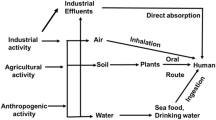Abstract
After a single intraperitoneal administration of lead in very small doses [1–100 μg Pbac/kg body weight (bw)], there was a dose-dependent, highly significant inhibition of erythrocyte D-aminolevulinic acid dehydratase (D-ALA-D) activity in mice. The maximal inhibition occurred between 3 and 24 h post injection (p.i.). After that, a rapid recovery of the D-ALA-D activity took place so that four days after lead administration, enzyme activity exceeded even the normal value. Only after eight days p.i. did the D-ALA-D value return to the initial level after a biphasic course.
After 10 i.p. injections of 0.1 to 10 μg Pbac/kg bw, there was again a dose-dependent, highly significant inhibition of the erythrocyte D-ALA-D activity in mice. The maximal inhibition was shown to be 24 h after the last lead injection. In contrast to the single i.p. administration, however, we found a monophasic course for the return of D-ALA-D activity. The D-ALA-D values did not exceed the normal range at any time after 10 i.p. lead injections. Ten and 30 days oral administration of lead corresponding to i.p. doses exhibited similar results in D-ALA-D inhibition.
Similar content being viewed by others
References
Abbrecht, P., Mouw, D., Vander, A., Kalitis, K.: The effect of chronic, low-level lead poisoning on the erythropoietin response to hypoxia. Proc. Soc. Exp. Biol. Med. 158, 109–112 (1978)
Baloh, R. W.: Laboratory diagnosis of increased lead absorption. Arch. Environ. Health 28, 198–208 (1974)
Baxter, C. S., Wey, H. E., Cardin, A. D.: Evidence for specific lead-d-aminolevulinate complex formation by carbon-13-nuclear magnetic resonance spectroscopy. Toxicol. Appl. Pharmacol. 47, 477–482 (1979)
Berlin, A., Schaller, K. H.: European standardized method for the determination of delta-aminolevulinic acid dehydratase activity in blood. Z. Klin. Chem. Klin. Biochem. 12, 389–390 (1974)
Davis, J. R., Avram, J. M.: A comparison of the stimulatory effects of cadmium and zinc on normal and lead-inhibited human erythrocytic d-aminolevulinic acid dehydratase activity in vitro. Toxicol. Appl. Pharmacol. 44, 181–190 (1978)
Dunnett, C. W.: A multiple comparison procedure for comparing several treatments with a control. JASA 50, 1096–1121 (1955)
Ehrlicher, H., Hoschek, R., Mappes, R., Pott, R.: Eine Diskussion des Merkblattes „Ärztliche Überwachungssuntersuchungen Blei“. Deutsche Gesellschaft für Arbeitsschutz e.V., 1972
Gelman, B. B., Michaelson, I. A., Bus, J. S.: The effect of lead on oxidative hemolysis and erythrocyte defense mechanisms in the rat. Toxicol. Appl. Pharmacol. 45, 119–128 (1978)
Granick, J., Sassa, S., Granick, S., Levere, R., Kappas, A.: Studies in lead poisoning. II. Correlation between the ratio of activated to inactivated d-aminolevulinic acid dehydratase of whole blood and the blood lead level. Biochem. Med. 8, 149–159 (1973)
Griffin, T. B., Coulston, F., Golberg, L., Wills, H., Russel, J. C.: Biologic effects of airborne particulate lead on continuously exposed rats and rhesus monkeys. Environmental quality and safety, Supplement Vol. III, Lead. Stuttgart: Thieme; New York, San Francisco, London: Academic Press 1975
Haas, T., Schaller, K. H., Valentin, H.: Über die Beziehung zwischen Blutbleispiegel, D-ALA-D-Aktivität und D-ALA-D-Ausscheidung bei stoßförmiger beruflicher Bleibelastung. Arbeitsmed. Sozialmed. Arbeitshyg. 7, 67–71 (1972)
Haeger-Aronson, B., Abdulla, B., Tristedt, B.: Effect of lead on delta-aminolevulinic acid dehydratase activity in red blood cells. II. Regeneration of enzyms after cessation of lead exposure. Arch. Environ. Health 29, 150–153 (1974)
Hapke, H., Prigge, E.: Interactions of lead and gluthatione with delta-aminolevulinic acid dehydratase. Arch. Toxicol. 31, 153–161 (1973)
Hernberg, S., Nikkanen, J., McIlin, G., Lilius, H.: Delta-aminolevulinic acid dehydratase as a measure of lead exposure. Arch. Environ. Health 21, 140–145 (1970)
Krasner, N., Moore, M. R., Thompson, G. G., McIntosh, W., Goldberg, A.: Depression of erythrocyte delta-aminolevulinic acid dehydratase activity in alcoholics. Clin. Sci. Mol. Med. 46, 415–418 (1974)
Lane, R. E.: Diagnosis of inorganic lead poisoning: A statement. Br. Med. J. 4, 501 (1968)
Lyberatos, C., Mitsion, C., Philippidou, A.: Erythrocyte delta-aminolevulinic acid dehydratase in hoozygous b-thalassaemia. Scand. J. Haematol. 12, 81–84 (1974)
Maes, J., Gerber, G. B.: Increased ala dehydratase activity and spleen weight in lead-intoxicated rats. A consequence of increased blood cell destruction. Experientia 34, 381–382 (1978)
Moore, M. R., Beattie, A. D., Thompson, G. G., Goldberg, A.: Depression of delta-aminolevulinic acid dehydratase activity by ethanol in man and rat. Clin. Sci. Mol. Med. 40, 81–88 (1971)
Nakao, K., Wada, O., Yanc, Y.: Delta-aminolevulinic acid dehydratase activity in erythrocytes for the evaluation of lead poisoning. Clin. Chim. Acta 19, 319–325 (1968)
Sakurai, H., Sugita, M., Tsuchiga, K.: Biological response and subjective symptoms in low level lead exposure. Arch. Environ. Health 29, 157–163 (1974)
Schlipköter, H. W., Pott, F.: Die pulmonale Resorption von Bleistaub. Internat. Symposium „Die gesundheitlichen Aspekte der Umweltverschmutzung durch Blei,“ S. 403–413. Amsterdam 1972
Secchi, G. C., Erba, L., Cambiaghi, G.: Delta-aminolevulinic acid dehydratase activity of erythrocytes and liver tissue in man: Relationship to lead exposure. Arch. Environ. Health 28, 130–132 (1974)
Selander, S., Cramer, K., Hallberg, L.: Studies in lead poisoning. Br. J. Ind. Med. 23, 282–291 (1966)
Shemin, D.: 5-aminolevulinic acid dehydratase: structure, function and mechanism. Philos. Trans. R. Soc. Lond., B. 273, 109–115 (1976)
Sroczynski, J., Jonderko, G., Watras, J.: Untersuchungen über die Lebensdauer der roten Blutkörperchen mittels radioaktivem Chrom (Cr51) experimenteller Bleivergiftung und bei prophylaktischer Anwendung von CaNa2 · EDTA. Int. Arch. Gewerbepath. und Gewerbehyg. 21, 223–230 (1965)
Tomokumi, K., Toshio, K.: Relationship between activation of delta-aminolevulinic acid dehydratase by heating and blood lead level. Arch. Toxicol. 34, 253–258 (1975)
Zielhuis, R. L.: Dose-response-relationship for inorganic lead. I. Biochemical and haematological responses. Int. Arch. Occup. Health 35, 1–18 (1975)
Author information
Authors and Affiliations
Rights and permissions
About this article
Cite this article
Schlick, E., Friedberg, K.D. The action of small doses of lead on erythrocyte D-aminolevulinic acid dehydratase in the mouse. Arch Toxicol 43, 213–220 (1980). https://doi.org/10.1007/BF00297586
Received:
Issue Date:
DOI: https://doi.org/10.1007/BF00297586




